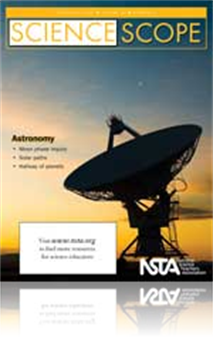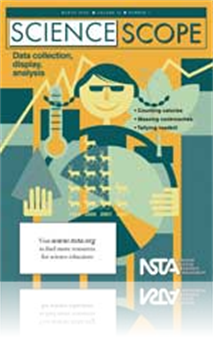All Science Scope resources
Journal Article
Science Sampler: Happy science Mother’s Day
It’s almost May and review for final exams will soon be in full swing. Mother’s Day is celebrated every second Sunday in May. Have students combine their use of science vocabulary and their love for Mom by creating scientific Mother’s Day greet...
Journal Article
Guest Editorial: The universe: It’s yours to discover—and to share
In 1609, Galileo turned his telescope to the sky and began a series of observations that would forever change our view of our place in the universe. This year, each and every one of us has an opportunity to follow in Galileo’s footsteps by taking a...
Journal Article
Science Sampler: Space moves—Adding movement to solar system lessons
Earth and space science figure prominently in the National Science Education Standards for levels 5–8 (NRC 1996). The Earth in the Solar System standard focuses on students’ ability to understand (1) the composition of the solar system (Earth, Mo...
Journal Article
Water You Engineering? An Activity to Develop Water-Quality Awareness
Water is one of our most precious resources. However, for many in the United States, having fresh, safe drinking water is taken for granted, and due to this perceived lack of relevance, students may not fully appreciate the luxury of having safe runn...
Journal Article
Scope on the Skies: Star light, star bright
In astronomy, the brightness of a star is described in terms of a star’s magnitude. Stellar magnitude is expressed two different ways, using the terms apparent magnitude and absolute magnitude. For both magnitudes, the numbering scale is the same, ...
Journal Article
Scope on Safety: Safety in the Science Classroom—An online resource from NSTA
NSTA’s Science Safety Advisory Board has developed a new online resource for science teachers, Safety in the Science Classroom. The document introduces the Standards of Student Conduct in the laboratory and in the Field (SSCLF)—a list of behavior...
Journal Article
Science Sampler: Plastics in our environment—A jigsaw learning activity
In this lesson, a ready-to-teach cooperative reading activity, students learn about the effects of plastics n our environment, specifically that certain petrochemicals act as artificial estrogens and impact hormonal activities. Much of the content i...
Journal Article
Big Macs and Healthy Teens? Exploring Fast Food as Part of a Healthy Adolescent Lifestyle
In the set of activities, explorations, and discussions described here, students apply healthy eating information when they make nutrition choices both at home and when eating out. These lessons introduce considerations such as portion size and calo...
Journal Article
Roadkill Data Analysis: Using Spreadsheets to Integrate Math and Science
The process of inspiring students into framing authentic questions and then providing them structured support in answering the questions through scientific research is widely recognized as a key element, if not the heart and soul, of inquiry-based sc...
Journal Article
Outstanding Science Trade Books for Students K–12 (Books published in 2008)
Today’s classrooms have no real walls! Students explore the world on field trips, during virtual journeys on the world wide web, and through the books they read. These pathways help them fly to the ends of the universe to satisfy their scientific c...




